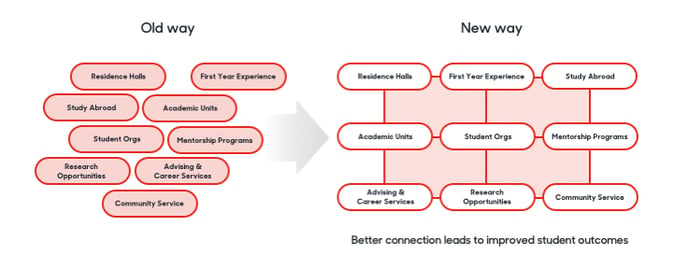
As the term ‘Experiential Learning’ has grown in popularity over the last several years, it seems every school now offers an experiential learning catalog.
What is contained in these catalogs varies widely from school to school. For some, it is a comprehensive list of potential Experiential Learning opportunities--from local community partnerships to study abroad and global learning programs. For others, the catalog is nothing more than a simple PDF organized by major. Still others provide links to course descriptions just like any other class offered on campus. No two schools are alike--even the question of Experiential Learning being a graduation requirement is up for debate.
But one thing is for sure--universities need to leverage the value of their physical locations and the millions of dollars spent on co-curricular programs each year. Schools across the country are on a mission to make these programs more accessible to students. How they do this however is clearly still an open question.
Leveraging Mobile-First Technology
At Suitable, we grapple with these challenges every day in an effort to help our partner schools increase engagement with campus activities and, ultimately, improve student success. Our gamified mobile app drives student engagement and, in concert with our Student Success Roadmap, includes a branded Catalog of Opportunities. With the Catalog of Opportunities, universities can create a centralized repository of all activities, while collecting valuable participation data, all in one place.
At first glance, this may seem simple: provide all your activities and experiential learning opportunities in one place, allowing students to access this information whenever they want from the place they spend the most time: their smartphones. But for many schools, this represents something entirely new. And that’s just the beginning.
Simplify Student Engagement
Students can find, track and share co-curricular activities and achievements from any mobile device. Each event or activity includes resource links such as Zoom conferences and informational materials so that students won’t have any confusion on where to go and how to participate. The Catalog of Opportunities even includes Experience Tags that filter activities to a student’s experience level and can be helpful when pulling engagement reports.

Administrators have the freedom to customize, add different events and tasks, and make the catalog unique to their school. Each submission has a wide range of tasks that can be put directly into the catalog, allowing students to submit reflections, portfolio submissions and surveys. This gives administrators real-time data on program success, while further engaging students and creating a bridge between outside-the-classroom activities and educational development.
The end result for students is a birds-eye view of all your university has to offer, and how these offerings can get students to where they want to go.
Utilize Data to Enhance the Student Experience
But perhaps the most important result of moving to a centralized, mobile-first catalog of all co-curricular opportunities is the abundance of experiential learning data you will collect. In just a few short months, school administrators will be able to see what activities their students are participating in, who is participating, and how much their students are participating in experiences. Discover which experiences drive engagement and better support students, create more informed student persistence and retention initiatives and make smarter budgetary decisions.
Lastly, if you have been considering making outside-the-classroom activities and experiential learning a part of your graduation requirements, staff and faculty will play an enormous role in helping students meet these requirements. In the same way that the catalog helps get new students feeling connected with the University more quickly, it also empowers faculty to aid in that process by encouraging students to use it to find ways they can get involved and meet their degree requirements in the most beneficial way possible.
Your institution no longer has to worry about organizing and presenting a plethora of activities to students. By leveraging the Catalog of Opportunities, both staff and students will benefit from having a designated space for all experiential learning activities. Furthermore, staff can take advantage of all the data that comes from using the Catalog to make the best choices for their students.


